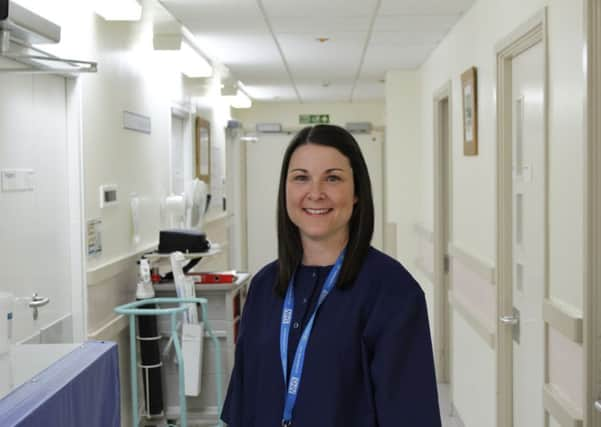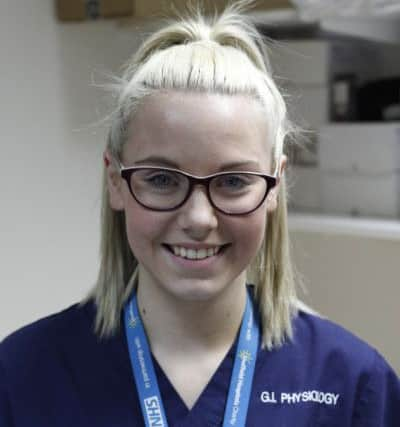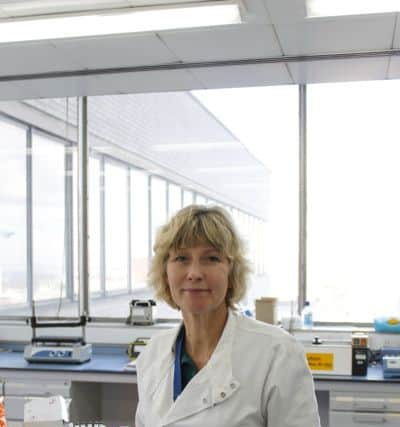REVEALED: The hidden stars of Sheffield's NHS system


These are the teams responsible for tasks as diverse as carrying out tests for swallowing disorders to advising staff on the regulations surrounding X-Rays.
Some of the dedicated staff working at Sheffield’s hospitals are featured here to mark Healthcare Science Week and de-bunk some of the myths about their specialist work.


Rebecca Mather
Advertisement
Hide AdAdvertisement
Hide AdHaving people you love in hospital can be a challenging time for anyone, but for Rebecca Mather it was a turning point for her career.
Seeing how well her grandparents were treated in hospital and the impact this had on her own family led her to want to be able to help others have the same experience.
After studying for her A-Levels, Rebecca was successful in gaining a position as a healthcare science apprentice in gastrointestinal physiology at Sheffield Teaching Hospitals.


Working closely with her supervisor, Rebecca has a role in carrying out investigations on patients with disorders in areas such as the small bowel.
Advertisement
Hide AdAdvertisement
Hide AdThe patients Rebecca sees may often feel embarrassed by symptoms these disorders can present, including flatulence, abdominal pain, wind and bloating.
Testing for many of these conditions is carried out by analysing methane and hydrogen levels in the breath.
After an initial assessment, the patient is given a drink of either glucose, lactose or fructose – sugars which are found in many common foods – and the breath test is then repeated.


Rebecca said: “While many of the patients may be quite embarrassed, I love getting the chance to talk to them and make them feel comfortable in the department. Knowing that I am involved in helping clinicians get the information they need to make a real difference to these patients’ lives is a great feeling.”
Advertisement
Hide AdAdvertisement
Hide AdRebecca now aspires to become a fully qualified clinical scientist.
Stella Bradey
Thousands of tests and investigations are carried out on patients every week in Sheffield, but most people are unaware of the behind-the-scenes work that goes into this aspect of care.


One group of people who are essential in this part of the healthcare system are biomedical scientists. They are often instrumental in enabling clinicians to assess a patient’s health, make a diagnosis, decide on a treatment course and monitor progress.
Stella Bradey is a biomedical scientist based at the Royal Hallamshire Hospital in Broomhill, and throughout her career has tested tens of thousands of blood and urine samples.
Advertisement
Hide AdAdvertisement
Hide AdStella’s working day can involve processing urgent samples, setting up and maintaining analysing equipment as well as staff training and ensuring all results are accurate and precise. Throughout her career, Stella has seen technological advances drastically change the way her work is carried out.
Stella explained: “When I started, it would take three days to get thyroid stimulating hormone test results. Today it takes just 20 minutes, on a machine that can run 170 samples every hour.
“We are also seeing an increasing number of pieces of laboratory equipment on the wards, in clinics and in GP surgeries. This is all about enabling medical staff to get the results immediately, with tests such as blood glucose, which in turn means patients are getting the right care much faster.”
Davina Hulme
Being unable to conceive a child can be a difficult time for those affected, but at Jessop Fertility, part of the Jessop Wing Hospital, staff can give people an opportunity to have a baby.
Advertisement
Hide AdAdvertisement
Hide AdDavina Hulme is one of those working at the clinic as a clinical embryologist.
Providing fertility treatments including IVF, embryologists help people who are struggling to conceive children. A large part of Davina’s role is spent with patients, as embryologists play an important role in the patient’s journey and are in contact with them throughout treatment.
An average day for Davina starts off by carrying out fertilisation checks for the patients whose eggs were collected the previous day. She will then check the development of other embryos to decide which patients are ready for embryo transfer.
Handling eggs and embryos is a complicated process and it is essential they are kept at the optimum temperature and PH levels.
Advertisement
Hide AdAdvertisement
Hide AdDavina is also involved in inseminating eggs through techniques including conventional IVF and ICSI, where a single sperm is injected into each egg.
These fertilised eggs, or embryos, are then transferred into the patient with any suitable spare embryos being frozen.
Davina said: “Getting the opportunity to help people is extremely rewarding. I have been an embryologist for 15 years and I’ve never looked back. I feel privileged to play such a significant part in the very personal journey our patients take to try and achieve the family they so desperately want.”
Shelley Redgate
There are a number of techniques available when diagnosing diseases such as cancer. A common method involves the use of radioactive imaging materials to detect and treat diseases including a range of cancers, heart disease and neurological disorders.
Advertisement
Hide AdAdvertisement
Hide AdShelley Redgate is a medical physicist in nuclear medicine based at the Royal Hallamshire Hospital and splits her working time between carrying out research and doing clinical work.
Her clinical work ranges from ensuring the equipment is working correctly to making sure the most up-to-date techniques are used.
Shelley said: “I really enjoy getting to work alongside a wide range of professionals including other physicists, technologists, nurses and consultant medics.
“Every day is different but the best part for me is when I solve a problem.”
Advertisement
Hide AdAdvertisement
Hide AdThe work that Shelley and her colleagues carry out provides consultants and other clinicians with the best possible images enabling them to diagnose or treat a patient’s cancer. Having accurate diagnosis means that patients are diagnosed as quickly as possible and the most effective treatment can be delivered.